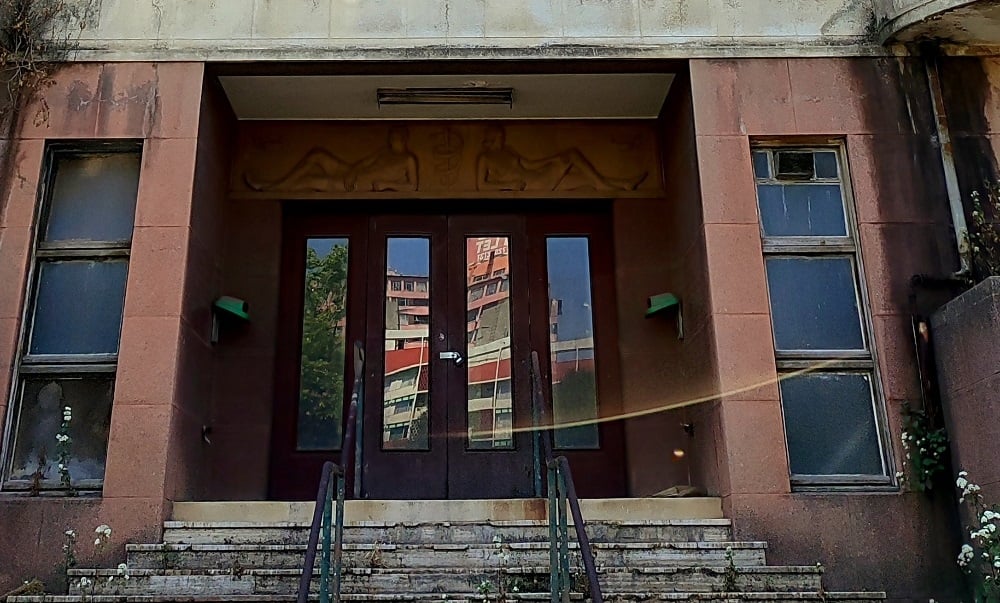Subscribers can listen to this article

Johannesburg's first general hospital was built on the "brow of the hill" in 1890. The building is now abandoned and derelict. (Ufrieda Ho/Spotlight)
- Hillbrow started out as Johannesburg's first health hub in the late 1880s.
- It's also been a suburb associated with pimps and prostitution, a middle finger to the National Party, and a key site of the HIV crisis.
- Today, it's the forgotten flatlands of inner city decay… but in small pockets it stays true to its heritage of bringing healthcare to the city's most overlooked.
Putting some distance between people and disease can sometimes be a smart idea. It's what early Johannesburg town planners had in mind when they decided that the city's first hospital should rise on the "brow of the hill", looking north away from the gold-flushed, but malady-stricken, mining centre.
Johannesburg's first general hospital opened in 1890. It was four years after Johannesburg was proclaimed a city under the Transvaal government with Paul Kruger at its head. With the hospital as an anchor in the suburb, Hillbrow would grow to become the health node of the city as it rushed into the new century with heady intentions to become a modern metropolis.
The Johannesburg General Hospital would treat miners arriving with crushed limbs and broken bodies from mining accidents, which were frequent. Other patients were admitted with respiratory illnesses and ruined lungs from breathing in silica dust as the angled reef under the Witwatersrand was drilled and crudely blasted for its yellow treasure.
SEE | Joburg's infrastructure crumbles as 'Jozi vs Jozi' calls for national intervention
From the shanties and old mining camps came those burdened with diseases of absent hygiene and sanitation and overcrowding. Typhoid, tuberculosis (TB) and dysentery were common. There would be malaria and smallpox. In 1905, the Rand Plague Committee published a report detailing outbreaks of pneumonic plague and bubonic plague in those first years of the new century. There would be waves of influenza as the "Spanish Flu" of 1918 swept through the country.
Author of Johannesburg Then and Now Marc Latilla writes that the first Johannesburg hospital located in Hillbrow was described as "lofty with handsome fireplaces". He writes that the hospital had 130 beds for black and white patients. More wards would come with expansion plans, but so would racially segregated healthcare. By 1895, a separate wing would be built for black patients.
Tumult and gold fever
The new city was being constructed against a backdrop of tumult and gold fever. Social tensions, divisions, and politics were also always in play.
In 1896, there would be the abortive Jameson Raid, an insurgency meant to usurp Kruger's government. The raid failed but it would ratchet up tensions between the Afrikaners and the British till the outbreak of the South African War in 1899.
The war continued till 1902. By the end of the decade, in 1910, the country would become a union, uniting the four old colonies of South Africa. In another four years, World War I would break out.
Medical and health historian Professor Catherine Burns, of the University of Johannesburg's Department of Historical Studies, says a more textured history reveals a story of whose health priorities ranked higher in the young city.
Joburg's first medical officer of health, Dr Charles Porter, arrived from Scotland and he would have looked at Johannesburg framed against his Glaswegian childhood.
"He would have encountered Johannesburg mining slums with Glasgow on his mind - seeing the conditions of crippled children and terrible miasmas; and an atmosphere of steam and filth as people staggered from the mines," says Burns.
But importing a system of healthcare would have its limitations. Burns points out that even as the Johannesburg General Hospital would count as modern advancement for medicine, the melting pot of people drawn to early Joburg brought with them vastly different beliefs on healing, on warding off sickness, and the meaning of wellness.
WATCH | From Ponte Tower: Nickolaus Bauer discusses Great Johannesburg, News24's Book of the Month
"Throughout the city - even today - we see the venerable men and women who seek out hilltops and high places to perform the rituals and prayers of healing and wellbeing. And of course many of these spots are in Hillbrow or Yeoville. It means we can't flatten everything, ignoring the layers upon layers of health history in the city," she says.
The melting pot was growing and "Hospital Hill" with it. The early part of the new century would see the establishment of facilities for nurses' accommodation, a fever hospital, a children's hospital, a mortuary, an operating theatre, nursing homes, maternity hospitals, medical research facility and a medical school.
Most ominous was the establishment of the "non-European" hospital built to further entrench racially segregated healthcare.
Kathy Munro, emeritus professor and heritage expert with the Johannesburg Heritage Foundation, says of particular significance was that the first Johannesburg hospital was built on state-owned land and with the intention of service. These were the nascent ideals of a public health service for the city.
The hospital was run by the Catholic Church's Holy Family Sisters until 1915.
Munro says: "You then had a clustering of private hospitals like the Florence Nightingale, the Colin Gordon and the Lady Dudley Gordon around the state hospital complex that ran from the top of the hill to the bottom. The South African Medical Research Institute, founded in 1912 and housed in a fine Herbert Baker building, also came up along Hospital Road.
"The health authorities would have had to deal with the fragmentation in society and the separated services for the Non-European hospital and a whites-only hospital," she says.
By the time apartheid was written into the statute book with the National Party coming to power in 1948, Munro says segregation would further shape the distribution of medical services in the city in the way Wits University had to deploy its medical students across the city.
"One of the inadvertent consequences of the apartheid system was that the university's medical faculty had to service many hospitals that were fragmented on the basis of race. But it also meant that more specialist professors in each discipline came to be stationed at these hospitals," she says.
By the mid-1960s and the 1970s, Hillbrow as health hub shifted. The new Johannesburg General Hospital - now Charlotte Maxeke Academic Hospital - would rise as a concrete hulk in Parktown in 1978 and the original Johannesburg Hospital was renamed the Hillbrow Hospital.
In these decades, Hillbrow also became the flatlands made up of residential highrises, distinct from the rest of suburbia. Its residents were mostly young European expat professionals, recruited to work in a South Africa that was in an era of economic boom. According to The Joburg Book, edited by Dr Nechama Brodie, the new arrivals from Europe boosted the white population in the country by 50% between 1963 and 1972.
Hillbrow was now a high density suburb with different pressures on health services. It was also a suburb, Brodie writes, that "acquired a cosmopolitan Bohemian character… and nurtured a subculture that incorporated elements of 'swinging London' and America's hippie culture".
Under the two iconic city landmarks of Ponte Towers and the Hillbrow Tower (Telkom Tower), Hillbrow was an unbounded playground, freer from the hang-ups of racial segregation and largely managing to evade the heavy hand of apartheid-era law enforcers and morality policing.
READ MORE | Several political parties dodge questions on how they plan to fix health in Gauteng
But by the mid-1980s, South Africa was in various States of Emergency and Hillbrow changed once again. White flight came on fast as more black people moved from the townships to Hillbrow, which was central, affordable and also anonymous.
Hillbrow's slide to urban decline came at the same time as the anxious steps towards democracy. Landlords absconded; the city council failed on upkeep, maintenance, and bylaw enforcement. Banks redlined the area, leaving Hillbrow to become an urban slum.
Professor Helen Rees, founder and executive director of the Wits Reproductive Health and HIV Institute (WRHI), picks up the story from the mid-1990s.
She says: "I had set up the Institute in 1994 and it was at the same time when HIV was just exploding. We started out in Soweto but worked with a public clinic dedicated to treating sexually transmitted infections (STIs) on Esselen Street in Hillbrow.
She adds:
I remember one morning when I got to the clinic the queue stretched around the corner, with about 100 people waiting. Of course, what we hadn't appreciated fully was that HIV was driving up the level of STIs hugely.
Hillbrow's population included groups not easy to link to and retain on care. They were young people, migrants and sex workers. It was enlarging the HIV challenge, Rees says.
Rees didn't baulk. She doubled down and decided that the WRHI should be located in Hillbrow, right next to the Esselen Street Clinic, one of the first clinics in the country to offer HIV testing.
Staying in Hillbrow means the WRHI has to invest in infrastructure, to have back-up for basics like water supply, generators, and security. These things are needed if the institute is to function as a global leader of science, innovation and research in fields like infectious and vaccine preventable diseases, sexual and reproductive health, antimicrobial resistance, and health in a time of climate change.
The institute was involved in Covid-19 vaccine trials, studies of the CAB-LA HIV prevention injection, and now they are involved in research on Mpox vaccines and on trials of the experimental M72 tuberculosis vaccine.
WRHI sits at the heart of that which survives of the Hillbrow health precinct. The Shandukani Centre for Maternal and Child Health that opened to the public in 2012 is also here. Other WRHI facilities include a clinic for sex workers, as well as a clinic for transgender people. Their neighbours are the Esselen Street Clinic, that endures in the distinctive Wilhelm B Pabst designed building from 1941, and the Hillbrow Clinic, that runs a 24-hour service. Along Hospital Street, the forensic pathology and national laboratory services still function.
Throbbing to a different pulse
But beyond the WRHI's electric fencing and street corners monitored by private security, much of Hillbrow life throbs to a different pulse.
Most noticeable is that one of the WRHI's immediate neighbours is the condemned building of the one-time Florence Nightingale Maternity Hospital. The building is now a so-called dark building, simply not considered fit for life.
The first Johannesburg Hospital stands derelict and abandoned, as does the chapel and the house the Catholic nursing sisters lived in when they tended to patients in the hospital.
And the Hillbrow streets live up to much of its bad reputation. It's overcrowded with people and garbage. Drug users curl up slumped against urine-soaked concrete benches as hawkers are forced to retrieve water from the city's smashed water pipes, and it seems every bylaw is ignored.
Rees is clear though that WRHI, which marks its 30-year anniversary this year, is exactly where it needs to be.
She says the coming needs for healthcare globally will focus on healthcare in slums and healthcare on society's periphery because more people's lives are precarious and more people will call slums home.
READ MORE | Joburg power outage takes out five health facilities, including three major hospitals
"The work we do is defined by the context and the needs of the population. But we have created a hugely professional context and run a state of the art institute," she says.
"You cannot do clinical research for the things that affect the majority of communities unless you're actually working in those communities."
It means some of WHRI's budget does go into fixing things in their neighbours' buildings – repairing pipes or cleaning up backyards turned to garbage dumps.
It's not technically their responsibility, but it is a response that helps them remain a relevant and durable pillar. And in a place like Hillbrow, where so many people survive by transience and invisibility, something that holds firm a little longer can make a big difference.
*This article was published by Spotlight - health journalism in the public interest. Sign up to the Spotlight newsletter.

We live in a world where facts and fiction get blurred
Who we choose to trust can have a profound impact on our lives. Join thousands of devoted South Africans who look to News24 to bring them news they can trust every day. As we celebrate 25 years, become a News24 subscriber as we strive to keep you informed, inspired and empowered.
Next on News24
South African investor flagged for alleged bribery in Ghana - report
1h ago

 (1).png)
 2 months ago
10
2 months ago
10



















